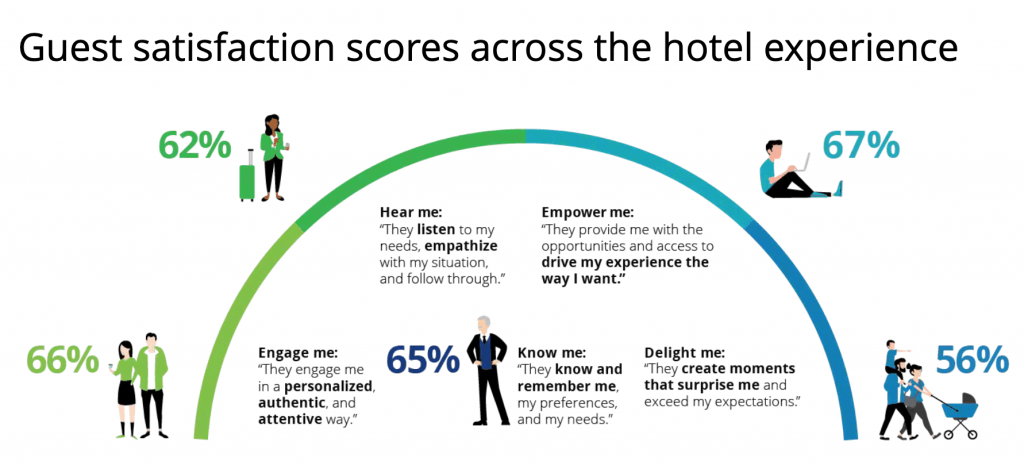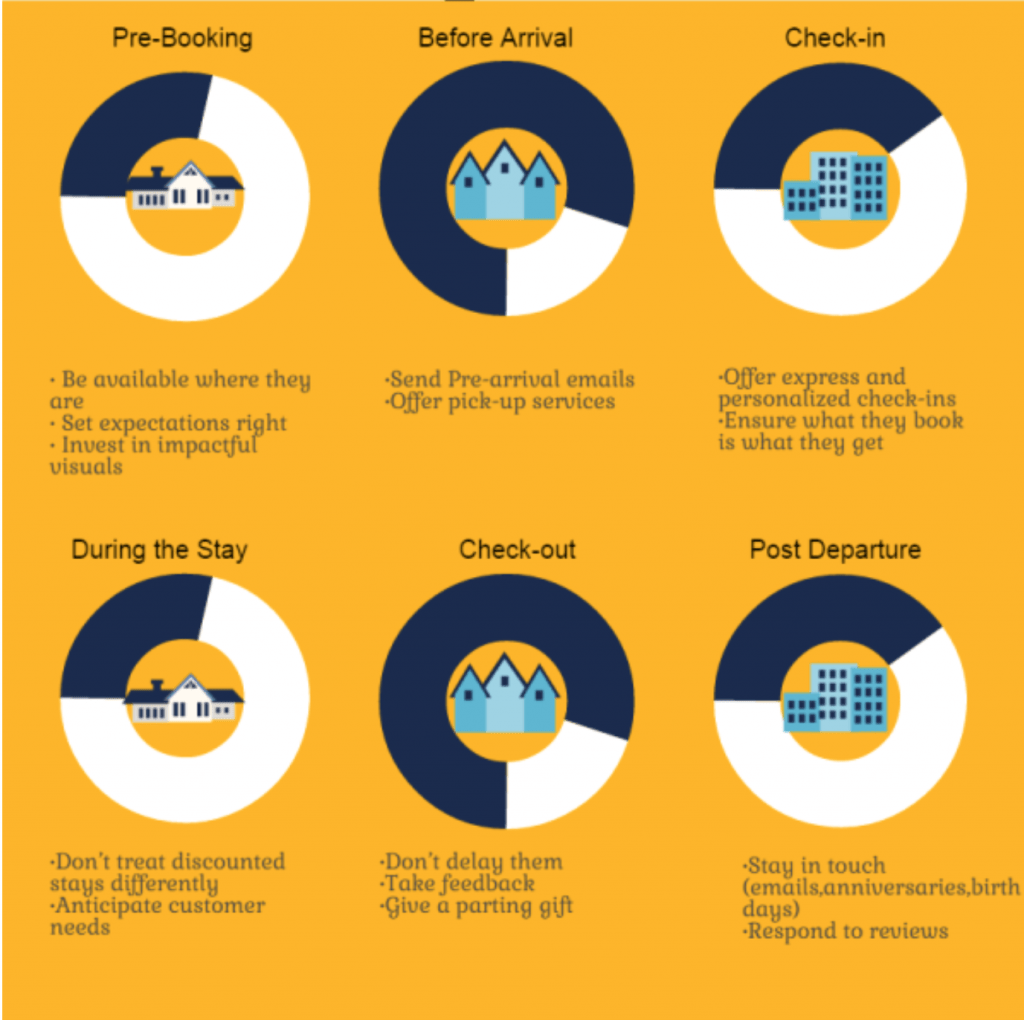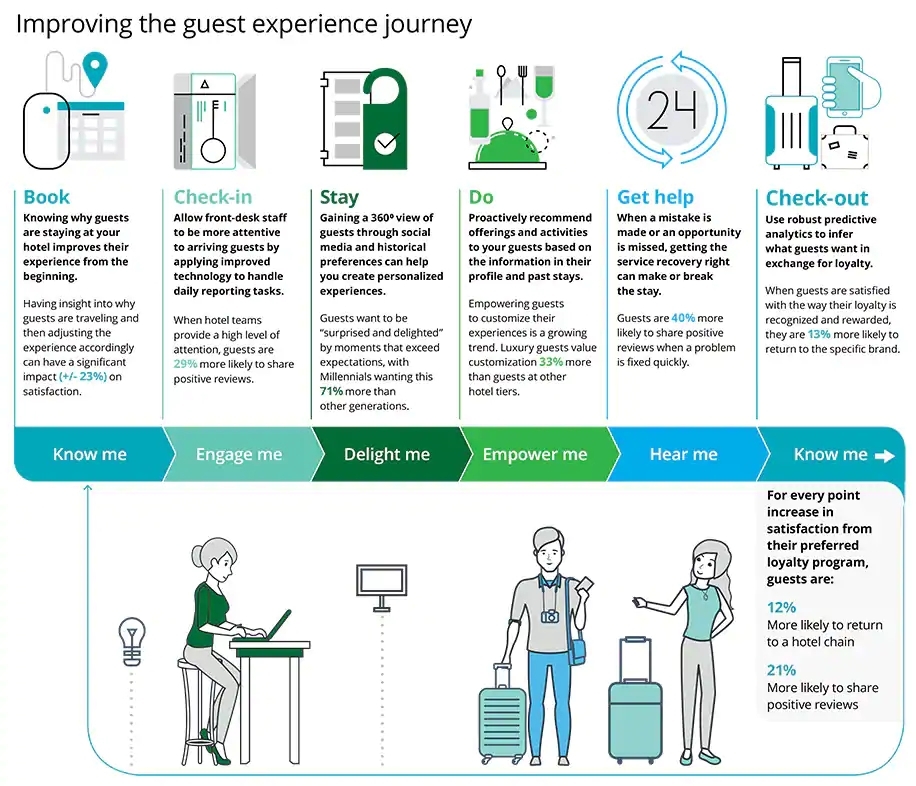Today’s guests have a host of expectations when it comes to their experience at hotels.
But when was the last time you actually asked your guests what they wanted?
Knowing your guests is foundational to pulling together the right kind of experience.
Not every hotel or hotel experience needs to have all the bells and whistles, the latest tech, or the fancy fixings. Instead, what counts more is if your guests have the right guest experience – both, for your brand and your hotel’s niche.

Engagement, listening, empowerment, knowledge, and surprising moments – these are the factors that lead to consistent guest satisfaction across the hotel experience.
So, the question is…what are you promising your guests?
What do guests experience from hotels today?
While hotels are trying to figure out what, precisely, their brand of guests are looking for, guests have no qualms in demanding more.
Part of this demand comes from a rapid-fire evolution of available tech in the hospitality sphere.
The other aspect is due to social media’s reach and influencer marketing – in particular, guests today take their recommendations, plan their itineraries, and choose hotels, locations, and rental providers based on social-media sponsored content.
Understand that, when it comes to travel and hospitality, hoteliers are the ones who seek to create this sense of escape, a haven where travelers can retreat, relax, and explore their surroundings.
It’s a promise inherent in the very notion of travel.
Because of this, a guest’s main expectation is one of authenticity – it’s absolutely necessary for a hotel to not only deliver on their promises but to listen to travelers, across the duration of their stay.

The above infographic perfectly captures the base requirements for any hotel to match when it comes to guest experience.
Each aspect of the guest’s stay should be a moment in which to capture, delight, engage, and gain further knowledge about preferences.
Just like what guests say they want from a hotel experience.
What is the reality of hotel experience for travelers instead?
Travelers expect, first and foremost, “customer service” to be of the highest standard. What’s tricky, however, is that this standard keeps rising.
The reality of the hotel experience for many travelers is sub-par at best. This is a missed opportunity given that 97% of customers report that customer service is key to their loyalty and 83% of customers view travel as a right, not a luxury.
It’s not only that they want to be heard, engaged, acknowledged, and actually surprised or “delighted”, as the stats reveal: Customers want the promises of hotels to be met – and then surpassed.
Instead, their frequent experience is often something like this:

Hoteliers need to consider what the first point of contact is during each interaction or “moment”. For example, during the moment of booking, customers’ expectations are very different than during the moment when they’ve arrived and have actually spent a night on the premises.

Each of these “moments” or points of interaction call for their own set of expectations and “customer service”.
By using technology and re-thinking the customer service aspect of each of these micro-moments, hoteliers can actually move the needle towards meeting customer expectations.
Take note of these five keys to improving guest experience. When combined with the above six points of interaction, any improvements you make – via technology, operational changes, loyalty programs, room features, etc. – will give you a major ROI.
It’s now time to consider the details on how to enhance the reality of your guests’ stay so that it actually matches, if not surpasses, expectations.
Using technology to make “upgrades” feel standard
In the hospitality business, you have a unique advantage: You have the ability to plan for and anticipate customers’ expectations.
And, thanks to the digital landscape, engaging with your customers can happen through multiple channels, multiple opportunities, and in a much more personal way. On the one hand, customers expect, for example, their queries to be responded to within 24 hours of inquiry.
But, on the other hand, hoteliers now have the technology to actually fulfill this promise – and go beyond, in several respects.
Let’s take a look.
Room Service
Expectations
Your customer expects on-demand, in-room “dining service” to suit their ordering behavior – this means it occurs online, occurs through a user-friendly interface, and should be available at any time of the day or night.
Reality
Often, what customers get is a service that is limited, in many ways. From hours of operation, to food quality, ordering experience, and even food variety, customers feel as though they’re at the mercy of what the hotel has to offer.
How to bridge the gap
Room service is incredibly important to the guest experience. No, your guests don’t want to avoid it – they want to have it be seamlessly integrated into their stay. They also want to make sure that there are dietary options that suit their needs. This includes gluten-free or vegan options.
See, 43% of guests say room service quality and speed is extremely important when selecting a hotel. 27% say that if a hotel doesn’t offer it, they simply won’t book.
To bring reality in alignment with expectations, use in-room tablets that feature a native app, allowing customers to order from the hotel’s menu as well as nearby, external options as well.
Create opportunities to search for options by preferences. For example, your native app could use tags to help guests search for specific cuisines or vegan options.
Amenities
Expectations
When guests book a stay at a hotel for a particular reason – an infinity pool, thermal springs, a beautiful rooftop terrace, for example – they’re looking for that expectation to be met.
This is the reason, after all, for their booking. And, for your brand, this is a distinct competitive edge. So you need to deliver on it. Luckily, you have the technology to back it up.
Reality
The reality is that, when they book, the experience being promised rarely lives up to a guest’s expectations.
Here, you’re missing out on the opportunity to seal your customer’s loyalty and actually live up to your promise.
How to bridge the gap
You want to fulfill three goals:
Keep guest expectations intact
Drum up their anticipation
Deliver authentically on your promise of amenities.
To do this, use a combination of social media and 360-degree camera technology to give your potential guest the opportunity to actually view or tour that special offering.
If it is an infinity pool, for example, you can feature others’ videos of your pool on your social media pages, such as your Instagram page or Facebook Business Page.
You can also harness review management sites and place a widget in a welcome email sequence that allows customers to trust that the experience or amenity they’ve booked for is actually what they’ll receive.
Room Features
Expectations
Without a doubt, guests expect a digitally-enhanced and augmented room experience.
From smart TVs that hook up easily to their latest apps and tablets, to smart-control temperatures, and automated functions like blinds or cooling/heating, their expectations are commensurate with their own in-home experience.
Since guests can call on digital assistants to help them finagle these environment controls in their own home, they expect hotels to catch up and re-create a similar experience of user control and personalized preference.
Reality
Unless you’re a boutique or independent hotel that can call the shots in a rapid-fire manner, chain or franchise hotels find it difficult to make changes – even ones they know their guests are expecting.
Because of the sheer size and scale of large-chain operations, independent franchise hotel owners/managers fail to make these hotel-wide changes in time.
Or, they simply don’t have the budget.
How to bridge the gap
Again, it’s difficult to implement these tech-based changes that augment the in-room experience if you’re either operating on a tight budget or you need to have changes approved by someone over you.
Instead, consider gaining permission to revamp just one or two rooms.
You can opt to offer these as a “beta” or a “VIP” experiences that customers will receive on a “discount” (or at standard cost) – in exchange for data. They’ll give you feedback, be available for interviews or surveys about their experience, and they’ll speak more about their preferences.
This way, you’ll gain invaluable and deeper insight into your guests’ needs, building a solid case for when you want to make these changes a standard and hotel-wide stipulation.
Check-In Experience
Expectations
The check-in experience should be smooth, seamless and, for the most part, completely automated.
Guests neither want to nor expect to stand in line all day, waiting for something as simple as a check-in.
While they’re always willing to be greeted, guided, and helped to their rooms, the actual communication, the hand-off of keys, and instructions should all be automated and personalized, via an app or through consoles and functionality within hotel lobbies.
Reality
Even though it’s incredibly easy to use highly flexible, powerful, and specific software, tailored to your hotel’s check-in process, many managers and owners are doing things the tedious way.
Often, there’s a fear that automation means the elimination of the human touch. This couldn’t be further from the truth.
Instead of wasting your customers’ time, having them wait in line to check-in, what could you do with five to seven extra minutes conversing with them, welcoming them, and assessing their needs?
And what might that do for your reputation?
How to bridge the gap
While some hotels are actually going as far as using robot “butlers” to guide guests to their rooms or welcome them, you don’t have to go that far (yet!)
A simple way to bridge the gap is to use software automation that takes care of the user-input required aspect of the check-in process. Allow users to make an account, hook them up with past room preference information, and give them rewards for performing certain actions.
In the meantime, your management staff is freed up to personally greet your guests, make recommendations, and troubleshoot real issues.
Conclusion
Technology can help you secure your guests’ next visit and guarantee their booking. Take time to actually think through the process of “goodbye.” You’d be surprised at how many opportunities there are to “convert” your guest.
The best time to capture their attention and create the next booking is when you’ve delighted them with their stay already. Using a loyalty rewards program or predictive analytics, you can create a personalized offer for their next visit that not only mimics this one, but it also enhances the experience further.








